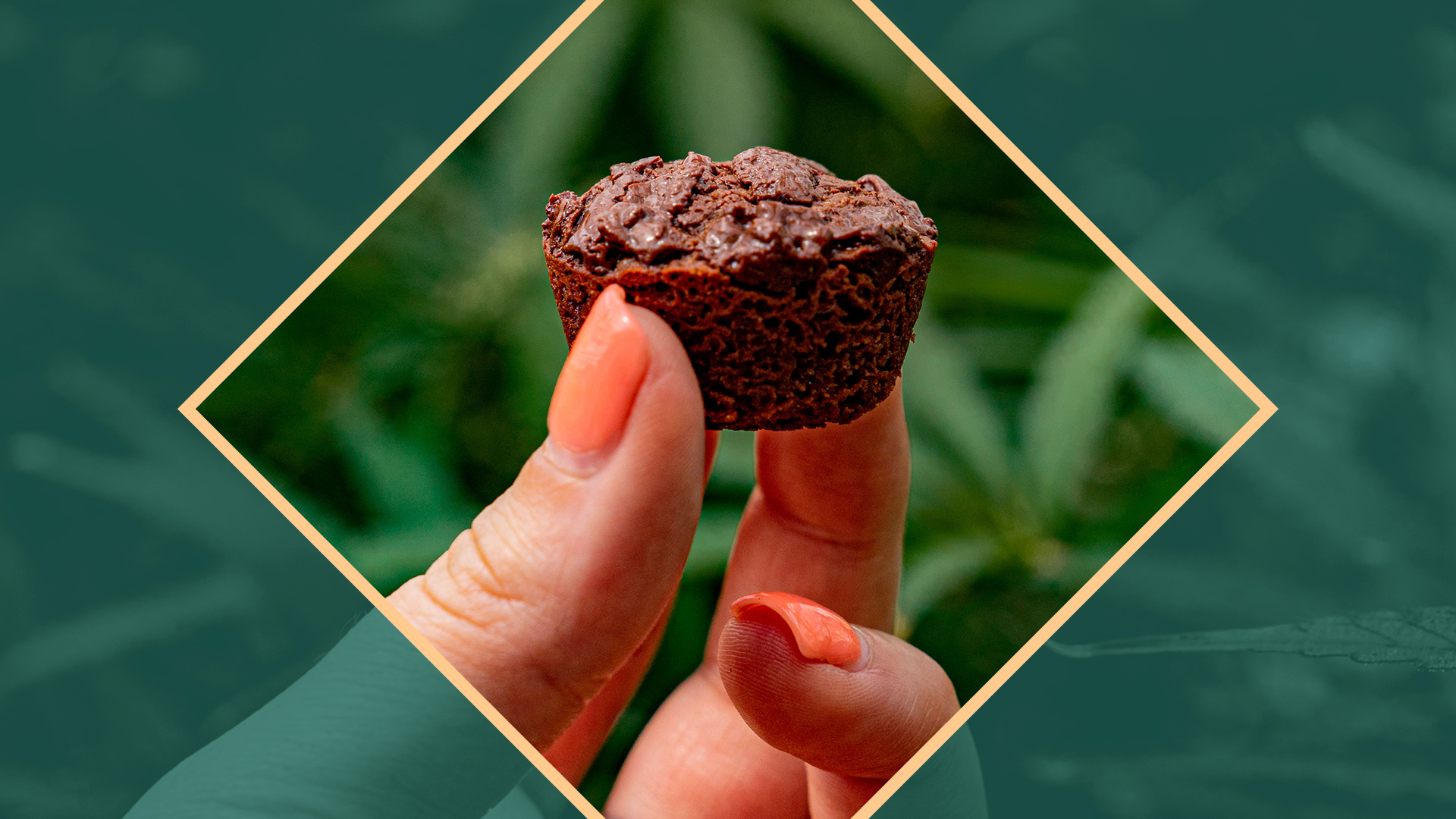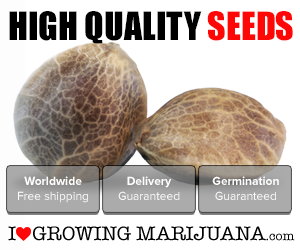Edible forms of cannabis, including gummies, mints, brownies, cookies, tinctures, drinks, and other food products, are discreet and can produce long-lasting, safe effects. They’re great when consumed responsibly, and when you know how much you’re consuming.
But edibles can lead you down an unpredictable path if you’re not careful, so it’s important to know what kind of experience you want to have.
Eating too much cannabis isn’t going to hurt your body, but unwanted or unpleasant effects from edibles can be avoided if you know the dose of the product and what dose of edible works best for you.
Edibles dosage chart by milligrams of THC
Here, we have composed a chart that describes typical effects many consumers have felt at different ingested doses of THC by milligram (mg).
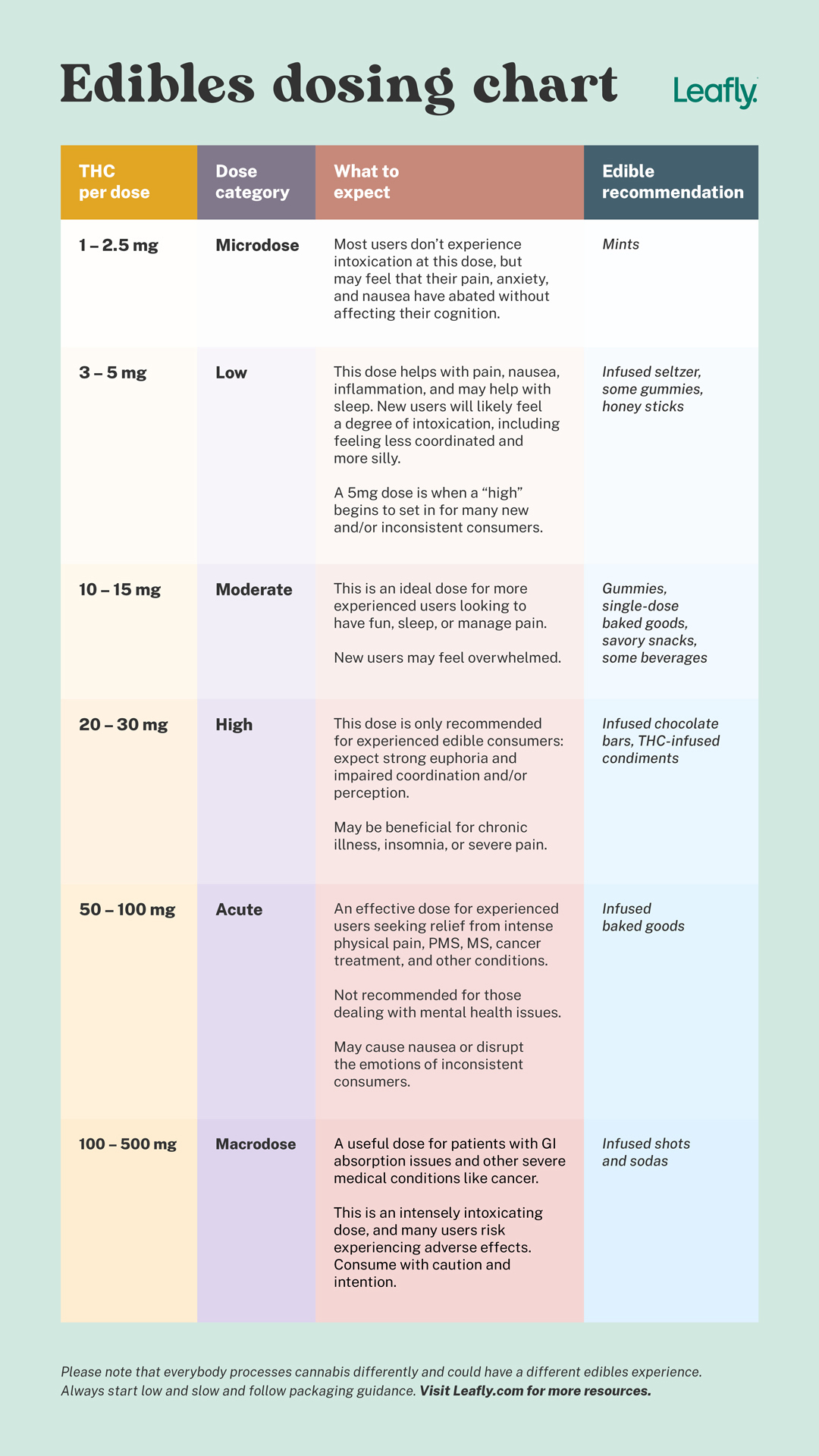
Remember, there are many factors that can impact your edible experience. Choosing the right dose for you and learning how much you can consume is a process and everyone’s body has the ability to respond to cannabis in a unique way.
Products bought at a licensed dispensary will have their dosage clearly labeled, but the dosage of homemade edibles is much harder to determine. Read on to learn about other factors that play into how edibles can affect you.
Finding your ideal edible dose
How many milligrams of edibles should you take? It’s important to note that each individual has an ideal dose best suited for them and their body. The strength of an edible depends on many factors, including:
- Type of edible
- Dosage
- Tolerance
- Body weight
- Metabolism
Two individuals may respond very differently to the same type of edible with the same dose—one may get very stoned, and one may not get stoned at all, depending on the above factors. Always start with a small dose of edibles and gradually increase until you find your ideal dose.
How body weight affects dosage and effects of weed edibles
Every person has a unique internal physiologic environment, and can therefore experience different results with various medications. One person’s response to a dose of edible cannabis can vary significantly from the next, even more so than other medications or herbs. Why?Several factors are involved, including previous history of cannabis use, gastrointestinal factors, and the function/sensitivity of one’s endocannabinoid system.
Once you go above 100 mg and into extremely high dosages of THC such as 150 mg, 200 mg, or even 500 mg marijuana edibles, the risk of sleepiness, nausea, and paranoia increase, even for consumers who consider themselves experienced users.
How many milligrams of THC should you eat to get high?
The ideal edibles dose depends on a lot of things, including tolerance, individual body chemistry, body weight, and the experience you’re looking for. Here are some basic guidelines to help you find the right dose, measured in milligrams (mg).
1 – 2.5 mg THC edibles (microdose)
- Effects: Mild relief of symptoms like pain, stress, and anxiety; increased focus and creativity. Most users do not feel any intoxication at this dose.
- Who it’s for: First-time consumers or regular consumers looking to microdose.
3 – 5 mg THC edibles (low)
- Effects: Stronger relief of pain and anxiety symptoms; euphoria; may impair coordination and alter perception. Five milligrams is a dose that can intoxicate some users.
- Who it’s for: Standard recreational use; consumers seeking relief from persistent symptoms not addressed by smaller doses; people looking for a good night’s sleep.
10 – 15 mg THC edibles (moderate)
- Effects: Effective relief for pain, nausea and anxiety symptoms; impaired coordination and altered perception;
- Who it’s for: High-tolerance THC consumers (both recreational consumers and medical patients); unaccustomed consumers may experience adverse effects. This is the maximum single dose for an edible in pieces, such as smaller cookies, gummies, mints, and chocolate bar pieces.
20 – 30 mg THC edibles (high)
- Effects: Very strong euphoria; very likely to impair coordination and alter perception.
- Who it’s for: Consumers with significant THC tolerances; patients with decreased GI absorption.
50 – 100 mg THC edibles (very high)
- Effects: Seriously impaired coordination and perception; increased possibility of adverse side effects, including nausea, anxiety, and increased heart rate.
- Who it’s for: Experienced, high-tolerance THC consumers; patients living with cancer, inflammatory disorders, or conditions that necessitate high doses.
100mg – 500 mg THC edibles (extremely high)
Effects: Intensely impaired coordination and perception; likelihood of unpleasant side effects including nausea, anxiety, and increased heart rate.
Who it’s for: Experienced, high-tolerance THC consumers; patients living with cancer, inflammatory disorders, or conditions that necessitate high doses.
How much of an edible should you take the first time?
If you’ve never taken edibles before, we recommend following the age-old adage: ‘low and slow.’ This means taking 2.5 mg to start with. Five mg is often considered one dose, so 2.5 mg is a half-dose, also called a microdose, which most users report not imparting intense intoxication or adverse effects.
Here are some tips for taking edibles for the first time:
- Edibles in dispensaries often come in 2.5 mg, 5 mg, or 10 mg doses, so we recommend buying gummies, mints, or another type of edible that can be cut up easily to make smaller doses.
- When buying edibles, check that the dosage is clearly labeled for each edible, so you know how they are dosed.
- Start low and go slow: Remember, you can always take more, but you can’t take less. Wait at least one hour after taking edibles, and if you don’t feel anything or want stronger effects after one hour, take another 2.5 mg.
For more tips for beginner cannabis consumers, check out our beginner’s guide to cannabis.
How long do cannabis edibles take to kick in?
Edibles usually take 20-60 minutes to kick in but can take longer based on many factors, like metabolism, GI issues, time of day, how much you have eaten, and more. We recommend you “start low and go slow.” Take a low dose of edibles and wait at least 45-90 minutes. If you want more effects after that time period, then take more edibles.
The most common mistakes in cannabis dosing occur when a person takes too high a dose for their tolerance, or doesn’t feel any effect from an edible after one hour and decides to take another dose. Two hours later, both doses come through, and the individual experiences the unpleasant effects of cannabis overconsumption.
Remember, if you take more edibles before waiting for the initial dose’s effects to kick in, both doses will kick in later, and you could potentially feel too high.
Learn more in: How long do edibles take to kick in?
What happens in the liver when you eat weed edibles?
Unlike smoking, vaping, dabbing, or using tinctures and transdermal products, our bodies digest cannabis edibles, and our livers metabolize their THC content.
Rather than absorbing into our bloodstream via the lungs or mouth or skin, our livers produce an enzyme, CYP2CP, that converts delta-9 THC to a more potent metabolite, called 11-Hydroxy-THC. But while 11-Hydroxy-THC can be up to three times as potent as inhaled THC, much of it can be destroyed during digestion, and our bodies absorb it less efficiently.
How long do the effects of a weed edible last?
The length of an edible high depends on the dose of the edible taken, as well as your tolerance, metabolism, and body chemistry.
For a moderately experienced consumer, an average 5 mg edible will typically last 2-4 hours from onset to comedown, with the peak of the experience at around 1 hour. If you have a high tolerance or fast metabolism, your high might wear off quicker. For someone with a low tolerance or slower metabolism, that 5 mg edible could last for up to 6 hours.
Some cannabis consumers enjoy edibles at night and may wake up still feeling the effects of the edible in their system. This may mean they want to take a smaller dose at night or dose earlier to match desired effects with sleeping patterns.
When taking edibles, it’s important to note how much you take to get a sense of how strong that dose is for you and how long it will last. This will help determine the ideal dose for you.
Understanding the effects of CBD and THC content in weed edibles
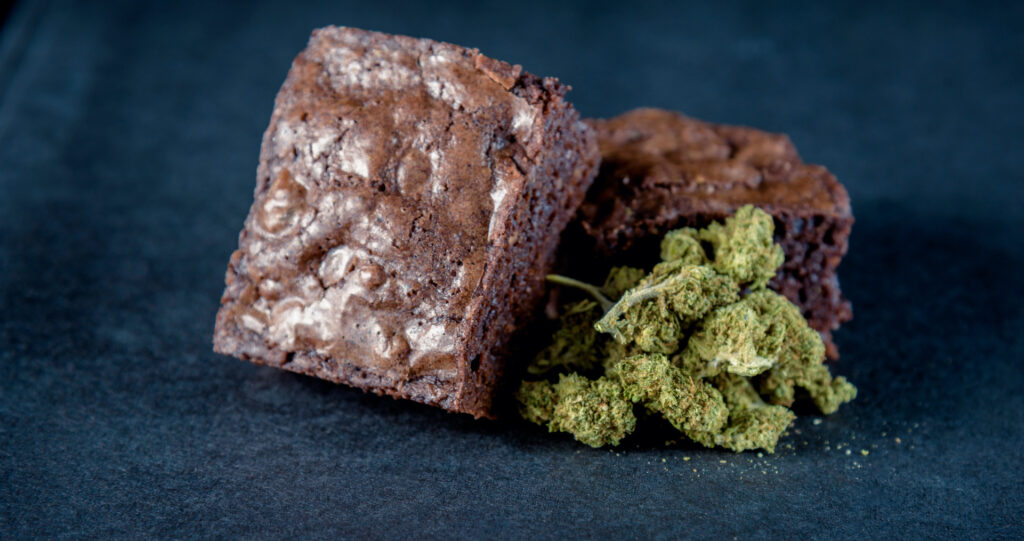
Adding CBD to THC can enhance the medical benefits of cannabis edibles and addressing ailments such as pain or anxiety, while also decreasing the intensity of intoxication and the accompanying adverse effects, such as impairment and elevated heart rate.
Because of its unique interaction with our endocannabinoid receptors, CBD partially blocks the intoxicating effects of THC, giving consumers medical benefits of cannabis without as much impairment. It’s important for consumers to know the contents of each of these components and the ratio of CBD to THC before ingestion.
Balanced edibles, or those with a CBD:THC ratio of 1:1, will be therapeutic and produce less impairment than edibles with just THC.
For example, a person who feels moderately stoned or impaired after taking 5 mg of THC will likely feel less or no impairment when taking 5 mg of THC with 20 mg of CBD.
Many brands available in dispensaries have expanded their ratios, and offer edibles with both higher and lower ratios of CBD:THC. As the amount of CBD in an edible increases, the likelihood of unwanted intoxicating effects goes down. Edibles can come in CBD:THC ratios of 2:1, 5:1, 10:1, 20:1, and more. Some may also incorporate other non-intoxicating cannabinoids, like CBG, or semi-intoxicating cannabinoids like CBN. However, keep in mind that consuming excessive amounts of edibles with THC, no matter how much CBD, can still produce unpleasant effects. Always check the labels for accurate dosing, and consult a budtender or medical professional familiar with cannabis’ effects.
How long does it take for weed edibles to wear off completely?
Edibles have the longest intoxication period of any other cannabis product for a single dose/session, and their effects taper off more slowly than with inhalation methods. Once the edible’s effects have peaked, they will plateau, and gradually lessen over the course of 1-2 hours.
Some consumers may feel tired after the effects have worn off.
If you have taken a dose that is too high for your comfort level, we recommend our guide on how to combat a too-intense cannabis high.
What to look for on weed edible labels
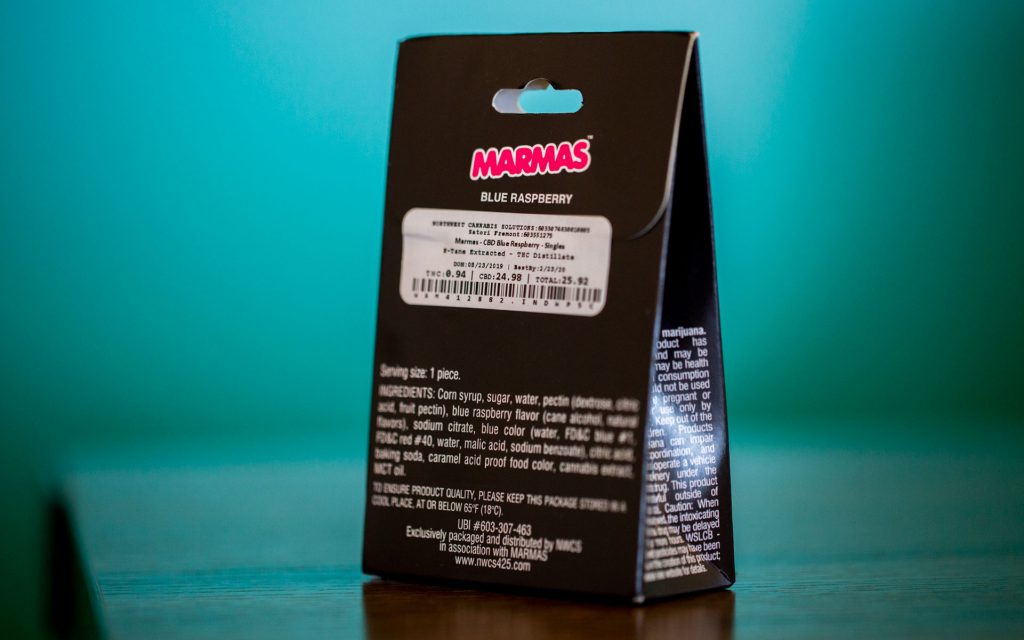
Can you overdose on weed edibles?
No one has ever reportedly died from consuming too much cannabis, but eating too many edibles can lead to an unpleasant experience. Unlike some opioids, cannabis does not depress the body’s respiratory system, regardless of dose.
Most people do not need emergency medical care, but consumers should always take caution when consuming edibles and be careful not to ingest levels of cannabis that will cause distress. Edibles are not for everyone.
What type of weed edibles get you the highest?
Different edible types have different ingredients and unique formulas, so even the same dose of a cannabis brownie won’t necessarily feel like a cannabis drink. Some have quicker onset times or are formulated for better absorption, but edibles typically begin to take effect between 15 and 60 minutes of ingestion.
- Hard candy and pastille edibles, like lollipops, gum, mints, and lozenges, as well as beverages, have some of the quickest onset times because they are absorbed primarily through the mouth’s absorbent tissue rather than going through the stomach tract.
- Chewy and sweet edibles like gummies, caramels, and chocolates have a median onset time because they do have to be digested, but are more quickly digested due to their simpler ingredients list.
- Baked goods tend to take the longest to take effect largely due to their density and the energy required to digest and metabolize them.
Is it safe to mix weed edibles with alcohol?
While cannabis alone has never resulted in death, interactions with other substances can range from unpleasant to dangerous. Alcohol is considered a depressant, and it affects the body by lowering activity in the central nervous system.
Additionally, because alcohol is a solvent, consuming cannabis and alcohol can increase the intoxicating effects of THC because alcohol allows it to more quickly and efficiently enter the bloodstream and brain. Recent research also suggests a combination of cannabis and alcohol can increase risk for traffic accidents. Learn more about how cannabis interacts with other substances here.
More tips for safe weed edible dosing
If you don’t feel any effects from an edible after one hour, try eating a snack, like fresh fruit, to stimulate digestion and help absorption in your gut. When consuming cannabis in any form, and especially edibles, we reiterate that you “start low and go slow.”
Even if you consider yourself a heavy smoker, you’ll likely have a low tolerance if you don’t regularly consume edibles, and may want to start with 2.5 mg, a half dose. Wait at least 60 minutes after eating to gauge the effects. If you want more effects, take another 2.5 mg, or even less.
Some people who are new to cannabis require 2-3 doses before they feel anything at all, so it’s often best to try the same low dose three times with 8 to 24 hours between trials before increasing the dose.
You may find that you aren’t experiencing the same effects as your friends, and that is okay. Everybody reacts to THC differently, and some individuals are more receptive than others.
In some cases, a large 50-200mg dose of CBD (without significant amounts of THC) can help minimize the effects of a high-THC edible.
Factoring in set and setting
It’s also important to have a positive space, set, and setting when consuming cannabis, especially edibles. Your set (mindset) and setting (environment) will greatly affect your cannabis experience.
If you’re in an anxious mood or in an unsafe space, you may have an unpleasant high; if you’re in a happy mood and a comfortable space, your chances of having a positive high will greatly increase.
However, taking too many edibles can still give you an unpleasant experience, even if you have a positive set and setting.
Remember to stay hydrated when taking edibles. Eating an edible on an empty stomach can also affect your weed experience—the effects will likely hit you more quickly and intensely. Your edible consumption will always be more manageable and predictable with a full stomach, as opposed to an empty one.
Now that you know the best edible dosage for you. What are you waiting for?
Dr. Dustin Sulak, Anna Wilcox, Amelia Williams, and Pat Goggins contributed to this article. This post was originally published on April 19, 2018. It was most recently updated on September 28, 2022.
Read the full article here



